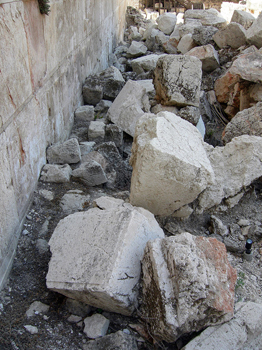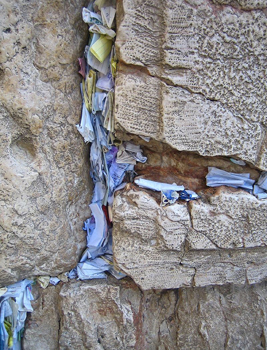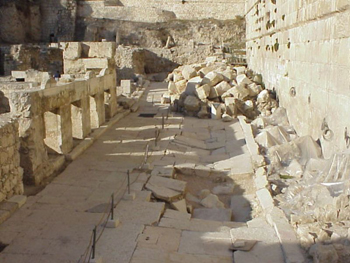In 2016, American author and social activist Adrienne Maree Brown wrote the following in reference to racial injustice and the Black Lives Matter movement: “Things are not getting worse, they are getting uncovered. We must hold each other tight and continue to pull back the veil.” If I could distill this week’s Gospel reading into just a few words, I would borrow Brown’s: Things are getting uncovered. Let's hold each other tight and pull back the veil.
As the Gospel of Mark describes the scene, Jesus is standing in the temple courtyard with his disciples, shortly after asking them to notice a widow surrendering her last two coins to the temple treasury. Dazzled by the architectural majesty surrounding them, one of the disciples asks Jesus to notice something in return: “Look, Teacher, what large stones and what large buildings!”
According to the 1st century historian, Josephus, the Jerusalem temple of Jesus’s day was an awe-inspiring wonder. Newly reconstructed by Herod the Great, the temple’s retaining walls were composed of stones forty feet long. The temple itself occupied a platform twice as large as the Roman Forum and four times as large as the Athenian Acropolis. Herod reportedly used so much gold to cover the outside walls that anyone who gazed at them in bright sunlight risked blinding herself.
Accordingly, the disciple in the story is impressed, and tries to share his sense of awe with Jesus. But Jesus isn’t dazzled. Instead, he responds to the disciple’s remark with a question: “Do you see these great buildings?” Why does Jesus ask the disciple if he can see what the disciple has just invited Jesus to see? Aren’t the two of them seeing the same thing? Well, no. They’re not. They’re not seeing the same thing at all.
 |
What the disciple sees is an architectural marvel, yes, but it’s also the biggest, boldest, and most unshakeable symbol of God’s presence he’s capable of imagining. For him, those massive stones hold religious memory. They bolster a colonized people’s identity. They offer the faithful a potent symbol of spiritual glory, pride, and worthiness. In short, what takes the disciple’s breath away as he gazes at the temple is the religious certainty and permanence those glittering stones display to the world.
That’s what the disciple sees. But what does Jesus see? He sees ruins. Rubble. Destruction. Fragility, not permanence. Loss, not glory. Change, not stasis. “Not one stone will be left here upon another,” Jesus tells the stunned disciple. “All will be thrown down.”
This passage from Mark’s Gospel is often described as apocalyptic. If you’re like me, your cultural references for “apocalypse” probably include Marvel superhero movies, the “Left Behind” fiction series, and the Book of Revelation. When I hear the word, I think of interplanetary warfare, the four horsemen, vacant-eyed zombies lurching through decimated neighborhoods, and the wholesale nuclear destruction of the planet.
But in fact, “apocalypse” means something quite different. An apocalypse is an unveiling. Or, to use Adrienne Maree Brown’s word again, an uncovering. A disclosure of something secret and hidden. To experience an apocalypse is to experience fresh sight. Honest disclosure. Accurate revelation. It is to apprehend reality as we’ve never apprehended it before.
In this sense, what Jesus offers his disciples is an apocalyptic vision. He invites them to look beyond the grandeur of the temple, and recognize that God will not suffer domestication. The temple is not the epicenter of his salvific work; God is not bound by mortar and stone. God exceeds every edifice, every institution, every mission statement, every strategic plan, and every symbol human beings create in his name. Moreover, God is not enslaved to superlatives; we’re the ones easily seduced by the biggest, the newest, and the shiniest. “Look, Teacher, what large stones and what large buildings!”
 |
In her sermon collection, God in Pain, Barbara Brown argues that disillusionment is essential to the Christian life. "Disillusionment is, literally, the loss of an illusion — about ourselves, about the world, about God — and while it is almost always a painful thing, it is never a bad thing, to lose the lies we have mistaken for the truth."
As I envision myself in the disciple’s place, listening in bewilderment as Jesus pops my spiritual bubbles, here are some of the questions I’m asking:
- What lies and illusions do I mistake for truth?
- In what memories, traditions, or comfort zones do I attempt to “house” God?
- On what shiny religious edifice do I pin my hopes, instead of trusting Jesus? (My denomination? My church? My spiritual heritage?)
- Why do I cling to permanence when Jesus invites me to evolve?
- Am I willing to sit with the fact that things fall apart? (Things I love, things I built, things I cried and prayed and strived for.)
- Can I embrace a journey of faith that includes rubble, ruin, and failure?
“Let us pray to God that we may be free of God,” the 13th century mystic Meister Eckhart writes, implying that our conceptions of God and faith must always fall short, always fail. Let’s name honestly, he suggests, the imposter gods we conjure because we fear the Mystery who really is. Let’s admit that we shape these gods in our own image, and that they serve us as much as we serve them. In other words, let’s endure apocalypse so that truth will set us free. Let’s dare to see what Jesus sees. Things are getting uncovered. Let’s hold each other tight and pull back the veil.
In the second part of the Gospel story, Jesus teaches his disciples what to do and how to live when the walls come tumbling down. Contrary to what our hysteria-hungry, “if it bleeds, it leads” culture so often encourages, Jesus insists on calm strength and generous love in the face of the apocalyptic.
“Don’t be alarmed,” he says, when truth is shaken, and nations make war, and imposters preach alluring gospels of fear, resentment, and hatred. Don’t give in to terror. Don’t despair. Don’t capitalize on chaos. God is not where people often say he is; he doesn’t fear-monger. He doesn’t incite suspicion. He doesn’t thrive on human dread.
So avoid hasty, knee-jerk judgments. Be perceptive, not pious. Imaginative, not immature. Make peace, choose hope, cultivate patience, and incarnate love as the world reels and changes. For me, this is the great challenge of the Gospel. Not simply to bear the apocalypse, but to bear it well. To bear it with the radical, self-sacrifical love Jesus models on the cross.
 |
For many of us, this has been an emotionally and spiritually exhausting week. We need look no further than the daily news to see apocalyptic images scarier than any Hollywood might produce. Here in California, thousands of acres of land are burning from massive wildfires. Entire neighborhoods have been reduced to ashes, and as one of my friends put it this morning, “There is a lament rising in Gilead, and it will not quiet for some time.”
Elsewhere, families are mourning in the aftermath of yet another mass shooting, or starving in the shadow of relentless war, or continuing to recover from hurricane damage, or suffering racial or sexual violence, or attempting to cross a national border because the horrors they leave behind are worse than the dangers that lie ahead.
In this troubling context, it’s easy to despair. Or to grow numb. Or to let exhaustion win. But it’s precisely now, now when the world around us feels the most apocalyptic, that we have to respond with resilient, healing love. It’s precisely now, when systemic evil and age old brokenness threaten to bring us to ruin that we have to “hold each other tight” and allow the veil to part, the walls to fall. What’s happening, Jesus promises at the end of this week’s Gospel reading, is not death, but birth. Something is struggling to be born. Yes, the birth pangs hurt. They hurt so appallingly much. But God is our midwife, and what God births will never lead to desolation. Yes, we are called to bear witness in the ruins, but rest assured: these birth pangs will end in joy.
Image credits: (1) Wikipedia.org; (2) Wikipedia.org; and (3) Pinimg.com.





